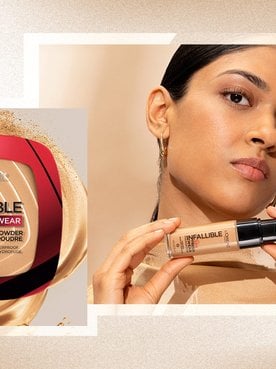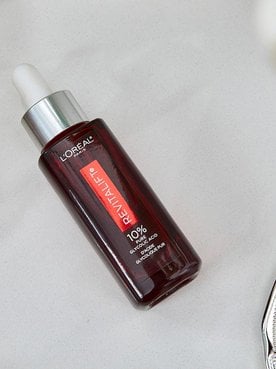There are many skincare concerns that fall outside of typical acne or wrinkles, including keratosis pilaris. If you have experienced small, persistent bumps on your legs or arms, you may have mistaken them for bug bites or a rash when they are actually keratosis pilaris. The condition can sound intimidating because of its name, yet it is common and generally harmless. A calm, consistent routine at home can help soften its rough, bumpy look.
Keep reading as we break down what keratosis pilaris is, what causes it, and gentle options you can fold into your daily and weekly skincare without disrupting your overall routine.
Shop the Products
What Is Keratosis Pilaris?
Keratosis pilaris or KP is a harmless skin condition and is more common than many realize. According to the Cleveland Clinic, it appears as tiny bumps on the skin that can resemble goosebumps or the skin of a plucked chicken, which is why some people call it “chicken skin.” It can show up on the face, typically the cheeks, as well as the upper arms, thighs, and buttocks, and it often feels rough or dry to the touch.
This skin condition can look like dry patches, small breakouts, or general irritation, so a gentle, observant routine helps you learn your skin’s patterns. If you see similar bumps near the scalp or along the hairline, a professional evaluation can clarify what is going on and guide care. The scalp has different needs than facial or body skin, so a tailored plan keeps things comfortable.
What Causes Keratosis Pilaris?
The main cause of keratosis pilaris is a buildup of keratin that forms small plugs at the openings of hair follicles. These plugs can create a patchwork of roughness and small bumps, sometimes with mild redness around follicles. The texture can be more noticeable when skin is dry, which is why consistent moisture and gentle care are central to daily maintenance, according to the American Academy of Dermatology Association.
Keratosis pilaris can affect anyone, but according to the Cleveland Clinic, it may be more noticeable on fair or light skin and is also common in people with a history of eczema, asthma, or allergies. If you're wondering how to get rid of keratosis pilaris, the key is to establish a routine that balances hydration and gentle resurfacing to help minimize the appearance of those bumps without overexfoliating.
Signs and Symptoms of Keratosis Pilaris
To spot the common signs of keratosis pilaris, focus on texture and tone rather than discomfort. Here are the main characteristics to help you identify keratosis pilaris:
- Small, rough bumps: The small bumps feel like fine sandpaper when you run your hand over the area.
- Mild redness around follicles: The skin around the bumps looks like a soft, pink halo that makes the texture appear more visible.
- Common locations: They often show up on the upper arms, thighs, cheeks, and buttocks.
- Itchiness or dryness: This happens especially after warm water or when there's low humidity.
What Helps With Keratosis Pilaris?
While there isn’t a permanent cure, steady home care can soften the look of bumps and help skin feel comfortable. Daily hydration, gentle resurfacing, and mindful shower habits sit at the heart of home treatment for keratosis pilaris. The steps below are simple, everyday habits that support smoother texture and a more even-looking tone over time.
Keratosis Pilaris Treatment #1: Over-the-counter lotions
Moisturizing formulas that include glycolic acid, lactic acid, or urea help loosen surface buildup while keeping skin cushioned. Pair gentle resurfacing with moisturizing to help your skin look smoother and feel more comfortable.
If you want to try glycolic acid for KP, consider layering the L’Oréal Paris RevitaLift 10% Pure Glycolic Acid Serum, which helps resurface for a more even-looking tone and smoother-feeling skin, supporting the appearance of clarity and refinement. Follow with the L’Oréal Paris RevitaLift Micro Hyaluronic Acid + Ceramides Line‑Plumping Water Cream to gently hydrate skin and reinforce a healthy-feeling barrier.

Shop the Products
Keratosis Pilaris Treatment #2: Medicated creams

Ingredients inspired by professional routines, including alpha-hydroxy acids, such as salicylic acid, and retinoids, can refine texture and help prevent the appearance of plugged follicles. Try the L’Oréal Paris RevitaLift 12% Pure Vitamin C + E + Salicylic Acid Serum in the morning to brighten the look of tone while refining texture.
In the evening, the L’Oréal Paris RevitaLift Pressed Night Moisturizer with Retinol + Niacinamide provides lightweight moisture and tone-evening, texture-smoothing care. With consistent use, this home treatment for keratosis pilaris will help you achieve a smoother, more balanced complexion.

Shop the Products
Keratosis Pilaris Treatment #3: Humidifiers
Indoor air can be very dry, which pulls moisture from the skin and makes roughness appear more visible. Place your humidifier where you spend the most time and keep it clean per the device instructions. When combined with a gentle moisturizer, added humidity helps maintain a plumped, hydrated look on arms and legs. Over time, that cushion can make texture appear less prominent, supporting your broader plan to get rid of keratosis pilaris.
Keratosis Pilaris Treatment #4: Exfoliation
Gentle, non-abrasive exfoliation helps lift surface buildup, so skin looks smoother and feels more even. A soft cloth or loofah can be used with very light pressure, focusing on consistency rather than intensity to avoid irritation.
You can also try the L’Oréal Paris RevitaLift Derm Intensives Gel Cleanser with 3.5% Pure Glycolic Acid to help gently resurface while washing. A soft, chemical exfoliant can be particularly helpful if you are trying to get rid of keratosis pilaris on the face. This step supports clarity without rough scrubbing. Keep in mind, there is no keratosis pilaris cure at home, so the goal is steady improvement in how skin looks and feels.

Shop the Product
Keratosis Pilaris Treatment #5: Laser treatment
According to the Cleveland Clinic, laser treatment can target redness and help improve the appearance of visible follicles. These professional treatments complement at-home care by addressing tone and the appearance of persistent areas. Consult a dermatologist to determine whether this option suits your skin and to outline a treatment plan that aligns with your goals.
Keratosis Pilaris Treatment #6: Shorter showers
Long, hot showers can strip surface lipids and leave skin feeling tight, which can make bumps look more apparent. Limiting shower time and choosing lukewarm water helps maintain comfort and reduce visible dryness. A quick pat-dry followed by moisturizer keeps hydration in while the skin is still slightly damp.
Keratosis Pilaris Treatment #7: Time
For many people, the look of keratosis pilaris softens with age, around thirty, especially when skin stays well-hydrated and gently resurfaced. Patience is part of the process, and steady routines typically deliver more reliable comfort than abrupt changes. Over time, skin can appear smoother, and texture may be less noticeable in everyday light.
Next Up: Blemishes Explained: How to Identify, Treat, and Prevent Skin Blemishes
Photo courtesy of L’Oréal Paris







